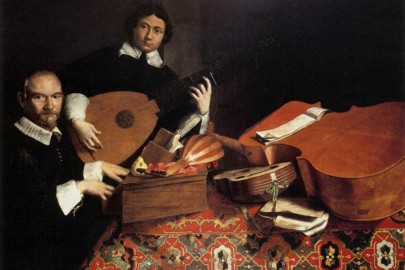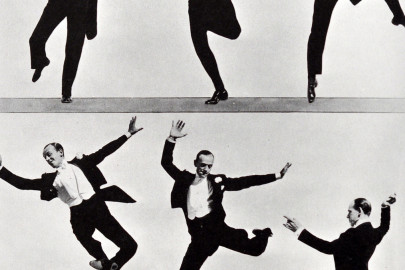From Bach to Bob Dylan, Mahlerman shares four of his ‘magic moments’ in music – those sublime instants when the hairs on the back of your neck stand to attention. What are yours?…
Two words that go together as naturally as ‘Edward’ and ‘Sophie’, or ‘waste’ and ‘space’, are the two words ‘magic’ and ‘moments’. Both the classic and popular musical canons are full of these goosebump instants when the ‘tingle factor’ emerges to surprise us, or perhaps remind us, like an old shoe, of a distant pleasure.
I used this ‘system’ when I first started finding girls interesting rather than irritating. And the plan was quite simple, and needed to be, as I lived at home with my mother and sister. Getting the girls into my room would be the difficult bit; after that, the slow third movement of Rachmaninov’s E minor symphony would do the rest for me.
I read recently that Joan Collins entices young men into her home using a trail of Werther’s Originals (but I don’t believe everything I read, naturally). I would probably have needed something stronger (chloroform?) to get Jean Martin into my bedroom (she had the good sense to marry David Duckham, who was taller, stronger and smarter than I, had fantastic blond hair, and no acne – and went on to be the greatest centre that English rugby ever produced) – but as it turned out, the sinuous clarinet theme that sets this wonderful movement in motion had a power greater than I could have imagined and to this day cannot explain. It brings on a sort-of sadness, a yearning regret – and strong girls crumble; men too.
There are many tempting examples that I could have chosen here: the solo ‘cello’s reappearance toward the end of the third movement of Brahms’ B flat piano concerto springs to mind: the conclusion of Honegger’s Third Symphony: the slide from the quietude of the third movement to the blaze of the fourth in Beethoven’s Fifth Symphony: and perhaps an all time favourite – not the first announcement of the wonderful hymn tune in the last movement of Beethoven’s Ninth Symphony by the low strings, nor the next statement by the middle strings and woodwind – but the sun-breaking-through-the-clouds moment which follows, before the whole orchestra joins, where the strings alone state the theme for the third time; if I had to pick one magic moment, it would be this one.
The various radio programmes that service these weaknesses, common to us all, would support the notion that we are more interested in other people’s choices than promoting our own, and I would therefore ask Dabblers, perchance those not normally disposed toward commenting, to give us some of your ‘private passions’. Here are some of mine.
That J S Bach was a revolutionary is rarely if ever put before us, the accepted line being that he was a practical composer, writing for such forces as were available to him at any given moment. But I invite you to listen to the opening aria of his amazing church Cantata BWV 54 Widerstehe doch der Sunde (‘Stand firm against Sinning’), as I did for the first time a few years ago. It has what the Germans call innig – it is deeply personal. The opening bars are shocking in their originality, with a throbbing E flat continuo, over which a dissonant 7th chord is floated; the tension is almost unbearable. And being a church Cantata, it is, in fact, a ‘musical sermon’, the dissonance illustrating that encroaching sin, if properly resisted, will eventually be dispersed.
Written around 1715 when the composer was barely thirty, it could have been minted yesterday, so advanced are the ideas contained within its brief frame; misquoting Gore Vidal, a little of me dies whenever I hear it. With idiomatic seriousness, it is played here by Musiciens du Louvre embracing the Parisian contralto Delphine Galou.
More than fifty years ago, in the Sofiensall in Vienna (gutted by fire in 2001) a recording took place that was meant to be special and, in the event, turned out to be legendary – the recording of the complete Wagner Ring Cycle by the Vienna Philharmonic Orchestra, the Vienna State Opera Chorus, and a cast of soloists that only a dreamer (and the then-deep pockets of Decca) could conjure-up, led by perhaps the greatest Brunnhilde ever heard, Birgit Nilsson. The whole project, lasting seven years, was masterminded by the producer John Culshaw and the Hungarian conductor Georg Solti.
And with sales now approaching 20 million, it is by some measure the biggest selling classical set of all time. Decca, obviously, took a huge financial risk by giving it the green light (it could never happen today), and it took forty years for the project to make-back its production costs.
But the result was an almost unqualified artistic triumph, with the few dissenting voices growling, predictably, about Solti’s ‘overdriven’ tempi, and lack of light and shade. They would have relished the opportunity to put forward the short video below as evidence, but for me it simply confirms, as in no other footage I have seen, that the ‘Screaming Skull’ was in his prime, creating a frightening tension in this, the last opera of the cycle Gotterdammerung. This vid shows a ‘final take’ of Siegfried’s Funeral March, with Solti in particularly energetic form – but when was the last time you heard such ‘electricity’ in orchestral playing? The Berlin Philharmonic have just left us after a short residency in London, where I heard them in Sibelius. It was a wonderful sound, a wonderful noise – but where was the danger?
My unrequited love for His Bobness has been ongoing now for almost fifty years, but he doesn’t know my pain – how could he? It wasn’t love at first sight, because first sight was 1966 in Birmingham, and a lot of people (I think they were called ‘folkies’) who had come to hear him got rather upset by the fact that he had decided to plug himself into the National Grid, and leave his Gibson and Martin in their cases.
But that was Bob; just when you thought you had him, he moved away. And he kept on moving away, kept on touring, kept on thinking and, like mercury, kept on slipping and sliding into the gaps between our expectations. Today, citing Frank Sinatra as a major influence, he gives us the ‘Great American Songbook’ in his latest essay Shadows in the Night. Who could have predicted that?
Eighteen years ago, after a fallow period in the 1980’s, Dylan hooked up with the producer Daniel Lanois and appeared with the album masterpiece that is Time Out of Mind. For reasons that are unclear, one of the best songs from the sessions that created the album was Red River Shore, but it didn’t make the final cut. It was eventually gathered into a collection of out-takes, and presented in The Bootleg Series – Vol 8 / Tell Tale Signs, and when I heard it I thought it could be his best song ever, running Mississippi (from Love and Theft) pretty close. If you haven’t heard it, I envy you.
I couldn’t put a cigarette paper between the three candidates for Best Night in the Theatre, but as the bogey-man Wagner is already with us, I will put aside his final transcendent opera Parsifal under Gergiev, along with an unforgettable evening in Bristol listening to Siegfried under Reginald Goodall. This leaves one of the greatest operas of the 20th Century, created when the composer was still in his twenties, Lady Macbeth of the Mtsensk District (1934) by Dimitri Shostakovich (above).
The lurid tale of sex and violence was an instant hit for the young composer, and followed as it was by the popular fifth symphony in 1937, it turned the shy, chain smoking young man into an international celebrity. Then, the roof fell in. Stalin attended a performance, leaving before the end, and Pravda later published their now-famous diatribe containing the phrase ‘muddle instead of music’ – and Dimitri was out in the cold; not quite literally, as he somehow avoided the Gulags, but his life was never quite the same again. The last production I attended, at Covent Garden, was the best by far, with the Dutch soprano Eva Maria Westbroek impersonating Katerina (Lady Macbeth) and Antonio Pappano in the pit. I couldn’t find a decent, short section from this production on YouTube but, whilst looking, stumbled upon this ‘top shelf’ excerpt from Act One, Scene 3. Katerina has just witnessed a near-rape (hence the muddy knees of soprano Ausrine Stundyte) her husband is away, and the dirty dog Sergey is about to connive his way into her bedroom and seduce her.
In this scene, which hardly needs describing, the bored housewife Katerina yearns for tenderness and love – and, let’s be clear, sex:
the wind caresses the birch tree and the sun warms it with his heat, for everyone there’s a smile from somewhere, but no one will come to me, no one will put his hand round my waist, no one will press his lips to mine. No one will stroke my white breast, no one will tire me out with his passionate embraces….
Best viewed after the nine o’clock watershed I think. I’m just off for a cold shower…..













Thinking about ‘magic moments’, I think there’s a theory to be developed about ‘tear-jerkers’ versus ‘spine-tinglers’.
So tear-jerkers are things like the Skye Boat Song or various Puccini arias, where the high notes soar higher and the low notes plunge suddenly lower than the ear expects, which for whatever anthropological reason goes straight to the human tear-ducts.
Whereas spine-tinglers and hair-raisers happen, I think, when some unexpected change in tone or tempo or sound comes in, and does so suddenly and with great confidence and certainty. Obvious examples: the first enunciation of ‘Zadok the Priest’ after the long crescendo; the first full chorus of Beethoven’s 9th.
Some pop examples that work on me and follow that formula:
– this by Laura Marling where the pleasant ‘Cross Your Fingers’ segues into the storming one-minute song ‘Crawled Out of the Sea’
– ‘She came in through the bathroom window’ when Paul goes into the third verse (‘And so I quit the police department’) when you expect a chorus
– the You and Me Song by the Wannadies
I think you’ve hit the nail on the head – spine tinglers to me are normally ones with a rising swell of sound or a big minor to major chord rise – Wagner’s Der Liebestodt, Mahler’s 5th, Strauss in Die Abendrot, Rihanna’s Umbrella.
Yes, those unexpected moments are among the best. Better still, passages so full of unexpected moments that one cannot believe there can be more – the chaconne at the end of Bach’s Partita No 2 for solo violin, for example, or the long harpsichord solo in his 5th Brandenburg Concerto, or the extraordinary cadenza that ends the third movement of Shostakovich’s 1st violin concerto. To mention just a couple of examples that you’ve reminded me of by including beautiful passages from these two composers. You just don’t want them to stop, and the twists and turns are just as unbelievable on repeated hearings.
Yes PW, I was going to include that very passacagalia, but couldn’t face the idea of cutting the movement into chunks a la Desert Island Discs. I clearly remember my mother buying the first recording by Oistrakh/Mitropoulos (1956?) and putting it into my hands – and of course I played the grooves flat over the next year or so. It still strikes me as the greatest of Shostakovich’s works, and perhaps the greatest ever performance of it by arguably the greatest violinist – and with the composer’s imprimatur, who could argue?
It’s difficult to exclude so many potent spine-tinglers, but there it is, and here are mine:
Sibelius: Seventh Symphony: Here – from 2 minutes 15 seconds – for about 10 seconds. I have a recording featuring Ashkenazy and the Philharmonia recorded in the glorious acoustic of the Kingsway Hall. The deeply resonant sound adds to the great thrill of it all.
https://www.youtube.com/watch?v=Eg7WsTuxMSQ
Elgar: First Symphony: The transition from the second to the third movement. It always makes me think of Elgar as the driver of a vehicle that has ten gears; the changing down is extraordinary; stunningly beautiful. Here – from 25 minutes through to and including the glorious tune at the beginning of the third movement.
https://www.youtube.com/watch?v=sCuSuwDXxUA
Shostakovich: Eleventh Symphony: A haunting cor anglais solo from 60 minutes 35 seconds and lasting for over 3 minutes. Magical!
https://www.youtube.com/watch?v=g9lo9ZDYuDU
Rachmaninov Vespers: All-Night Vigil: The complete Second Movement: Praise the Lord, O My Soul. What can you say?
https://www.youtube.com/watch?v=iCgIswP7jPY
Joni Mitchell: A Case of You. From my favourite JM album: Blue. Glorious! Spine-tingling at its best.
https://www.youtube.com/watch?v=5obQZG_ZmZo
These days I find Vaughan Williams’ Serenade to Music virtually one long tingle – such achingly beautiful English music – and Shakespeare too! As for moments, what about the coming in the of the great Song of Thanksgiving in Beethoven’s A minor string quartet? Or, still more, the final full-force surge of Dona Nobis Pacem at the end of the B Minor Mass…
With you all the way regarding the Solti Ring, Mahlerman, an extraordinary experience.
For me, Don Giovanni would figure in there somewhere, here’s wor Liz chucking a bit of a wobbler, Schwarzkopf’s aria, Who is there, who will tell me where the rascal is, ah! me che dice mai has her in full flood, at her barking best, backed by her hubby, Walter Legge’s own creation, The Philharmonia Orchestra, Giulini at the helm and, of course, a wondrous celebration of Mozart’s genius. The generated adrenalin rush from this aria is similar to that having just kicked the arse of the Peuterey Ridge, as we trudge over the Mont Blanc summit, at midnight, in a force nine, homeward bound.
From such a list who could omit Bach, the partita BWV1004 and it’s Ciaconna swings into view, Amandine Beyer in charge, encased within this music is everything that the soul could possible desire, no tingles or shivers, sweet dreams are made of this.
Here’s the lassie from Blackburn, singing a Northumbrian song tears asunder the stiff upper lip; creates not shivers for the spine but a tsunami, not easy, running out of superlatives for this one.
Thanks Malty – not least for an introduction to Amandine Beyer. What a player! One of the technical peaks of the violin repertoire, it is important, I feel, that however good you are, it should not sound ‘easy’. She somehow reveals the effort involved, and yet plays it perfectly, even in the fast passages managing to keep ‘a tempo’, and a perfect rhythmic sense. Almost unbelievable.
And ‘our Kath’ – in Mahler with Walter she leaves me drained, but all alone on a Northumbian hillside, but actually in London in 1949 with four years to live, she fair does a man’s head in. What a woman, what a voice.